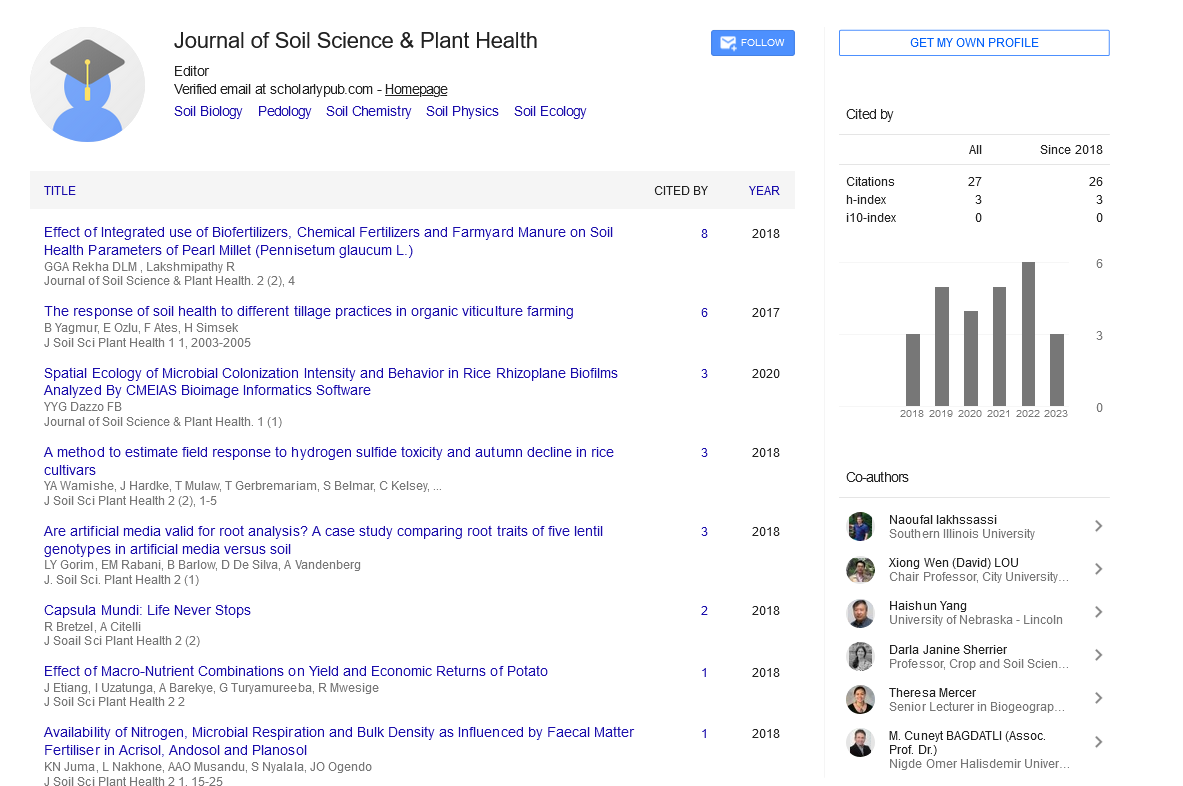Commentary, J Soil Sci Plant Health Vol: 8 Issue: 1
Biological Indicators of Soil Health and Plant Performance
Seok Bum*
Department of Agronomy, University of Cordoba, Rabanales Campus, Ctra. de Madrid-Cadiz, km 396, 14071 Cordoba, Spain
- *Corresponding Author:
- Seok Bum
Department of Agronomy,
University of Cordoba,
Rabanales Campus,
Ctra. de Madrid-Cadiz,
km 396,
14071 Cordoba,
Spain
E-mail: seokbum34@gmail.com
Received date: 27 October, 2023, Manuscript No. JSPH-23-118472;
Editor assigned date: 30 October, 2023, PreQC No. JSPH-23-118472 (PQ);
Reviewed date: 13 November, 2023, QC No. JSPH-23-118472;
Revised date: 05 January, 2024, Manuscript No. JSPH-23-118472 (R);
Published date: 12 January, 2024, DOI: 10.4172/jsph.1000218
Citation: Bum S (2024) Biological Indicators of Soil Health and Plant Performance. J Soil Sci Plant Health J 8:1.
Description
Soil health is a fundamental component of sustainable agriculture and ecosystem stability. It is not merely about the physical and chemical properties of the soil; biological indicators play a crucial role in assessing soil health and predicting plant performance. The interactions between soil microorganisms, plants, and the overall soil ecosystem are complex and dynamic. The significance of biological indicators in evaluating soil health and their influence on plant performance. The health of the soil is integral to the health of the plants it supports, making it crucial to assess and monitor soil conditions accurately. Biological indicators, such as soil microorganisms, earthworms, and mycorrhizal fungi, play a pivotal role in reflecting soil health and, consequently, plant performance.
Biological indicators of soil health encompass a diverse range of organisms, including microorganisms, earthworms, arthropods, and plants themselves. These indicators provide insights into the functioning of the soil ecosystem and its ability to support plant growth. Some key biological indicators include:
The abundance and diversity of soil microorganisms, such as bacteria, fungi, and archaea, can indicate the soil's capacity for nutrient cycling, organic matter decomposition, and disease suppression.
The metabolic activity of microorganisms, measured through processes like respiration and enzyme production, reflects the soil's ability to release nutrients for plant uptake.
Earthworms and other soil-dwelling organisms play critical roles in nutrient cycling, soil structure improvement, and organic matter decomposition.
The presence of diverse plant species and their overall health can be an indicator of soil fertility and nutrient availability.
Mycorrhizal fungi form symbiotic relationships with plants, enhancing nutrient uptake and stress tolerance.
Biological indicators are essential in assessing soil health due to their sensitivity to changes in soil conditions and management practices. Monitoring these indicators provides valuable information about the following:
The activity and diversity of soil microorganisms indicate the soil's capacity to recycle nutrients, reducing the need for synthetic fertilizers.
Soil microbial activity and the presence of decomposers influence the breakdown of organic matter, which enriches the soil with humus and nutrients.
Soil microorganisms can inhibit the growth of plant pathogens, contributing to healthier plants and reduced disease incidence.
Earthworms and other soil fauna contribute to soil structure through burrowing, enhancing water infiltration and root growth.
The presence of beneficial mycorrhizal associations can enhance plant nutrient uptake, leading to improved crop yields.
The intricate relationships between plants and soil microorganisms significantly impact soil health and plant performance:
Mycorrhizal fungi form symbiotic associations with plant roots, increasing the root's nutrient-absorbing surface area and enhancing nutrient uptake.
Plants release organic compounds, known as root exudates, into the rhizosphere, which attract and support beneficial soil microorganisms.
Plant residues, such as leaves and roots, provide organic matter for soil microorganisms, contributing to nutrient cycling and organic matter decomposition.
Some soil microorganisms, known as bio control agents, can suppress plant pathogens, reducing the risk of disease outbreaks.
Land management practices, such as tillage, crop rotation, and agrochemical use, significantly influence biological indicators and, subsequently, soil health and plant performance: Reduced or no-till practices help maintain the soil's biological activity and organic matter content.
Diverse crop rotations can enhance soil health by promoting beneficial microbial communities.
The use of pesticides can disrupt the soil microbial community, affecting nutrient cycling and disease suppression.
Proper fertilizer management can prevent nutrient imbalances and support soil microbial activity.
Conclusion
Biological indicators of soil health and plant performance are integral components of sustainable agriculture and ecosystem management. The interactions between soil microorganisms, plants, and the overall soil ecosystem play a pivotal role in nutrient cycling, organic matter decomposition, and disease suppression. Understanding and monitoring these indicators can guide land management practices, leading to healthier soils, increased crop productivity, and improved ecosystem stability. As we continue to explore the intricate world of plant-microbe soil interactions, we gain valuable insights into sustainable agricultural practices and ecosystem health.
 Spanish
Spanish  Chinese
Chinese  Russian
Russian  German
German  French
French  Japanese
Japanese  Portuguese
Portuguese  Hindi
Hindi 